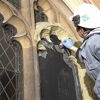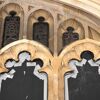Show all
Further references
The structure showed cracks in some places, for which there were different causes. Improved statics and higher load capacity were achieved by stiffening the structures, frictional connection of the disturbed foundation and decoupling the components gate, passage hall and gate houses components. Particularly on the western side, intense blackening of the rock surface had built up, which was strongly interlocked with the ground. The deposits were composed of a mixture of soot and plaster. The cleaning process carried out in 1990 with the help of water could only result in a superficial cleaning. In 2002, the newly developed method of particle beam cleaning and cleaning by laser made it possible to remove soot and plaster without destroying the original surface.
Continue reading
Elbe Philharmonic Hall, Hamburg
Hamburg
On the façade surfaces of Kaispeicher A, there was a lot of efflorescence and lime aging, both signs of penetrating moisture. The damage patterns indicated a lack of frost resistance as well as no protection against driving rain. The listed façade required extensive frost and moisture protection, but was not allowed to undergo any visual changes.
Continue reading
In the large pumping station with external drainage channel and underground pool area, biogenic sulfuric acid corrosion was shown at an advanced stage.
Continue reading







